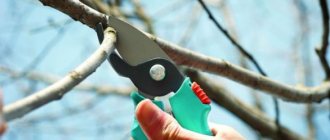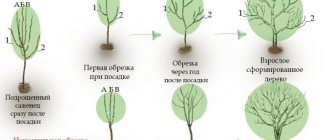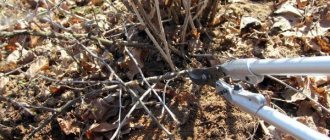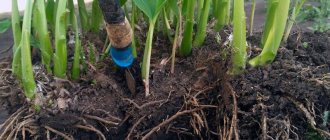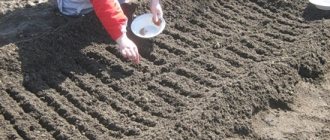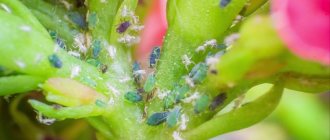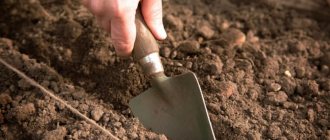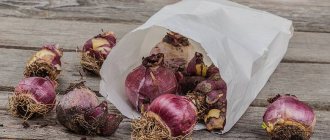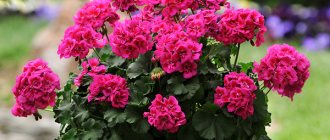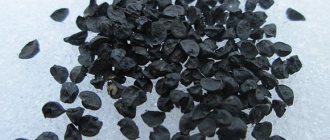Actinidia care basics
Proper planting and complete absence of pests make caring for actinidia easier. For better plant growth and increased fertility, it is advisable to provide it with supports - trellises (galvanized wire between the posts).
Important! Planted cuttings from lignified actinidia cannot be replanted for at least two years - their root system must become stronger.
Watering and fertilizing the soil
Watering actinidia is moderate. Excessive moisture should not be allowed (the soil at the roots serves as an indicator). All actinidia love spraying the leaves with water dust (morning and evening).
Fertilizers are selected taking into account the preferences of the plant (slightly acidic and acidic soils) - potassium chloride, ammonium sulfate, ammonium nitrate, wood ash, etc.
Chlorine-containing fertilizers such as
lime and fresh manure are strictly contraindicated.
Before feeding actinidia in the spring, after the snow melts, you need to shallowly loosen the soil near the roots (3-5 cm). Do not dig up - you can damage the roots. You need to feed:
at the beginning of spring (mulch with organic matter and fertilize - for each square meter - 35 grams of nitrogen, 20 grams of phosphorus or potassium fertilizers);
mid - late spring (ovary formation) (per square - 15-20 grams of nitrogen, 10 grams of phosphorus and 10 grams of potassium fertilizers). In summer, you need to constantly monitor the root collar, add more soil when it is exposed;
at the end of the harvest, before winter. Lianas are fertilized with superphosphate and potassium chloride
The roots are additionally covered with a layer of peat and leaves.
Important! Actinidia are sometimes affected by leaf spot and gray fruit rot. Young plants (shoots and especially roots) can be eaten by cats
To preserve the roots, the planted sprouts are fenced with a metal mesh.
How to trim correctly
Caring for actinidia involves regular pruning of the plant.
. Pruning is necessary for a young vine (for its proper formation) and an adult plant (the constant growth of the vine leads to thickening, darkening, and reduced yield).
When planning pruning, consider the following:
- The most optimal time for the procedure is considered to be the summer months, immediately after flowering has completed;
- in the fall, about a month before frost (the timing of frost may vary in different regions) - pruning is not recommended (the awakened buds and young shoots will not ripen and frost will kill them). In the southern regions, sanitary pruning is carried out after the end of leaf fall;
- in early spring (when the sap moves through the vine), pruning is prohibited - any violation of the integrity of the plant is fraught with its death.
Important! Each actinidia variety has its own specific characteristics that must be taken into account when pruning. For example, in a kolomikta tree older than 8 years, one old branch is cut off annually and replaced with a young shoot
Colomikt in the form of a bush bears fruit poorly and needs trellises. In argut, the main vine lasts a lifetime, but it needs to be thinned out more intensively and cut shorter (short shoots bear fruit), etc.
Pruning young actinidia is associated with the formation of the plant.
- the first year - cut off the above-ground part, leaving 2 - 3 buds;
- the second year - all shoots are cut off, except 2 - 4 vertical ones (sleeves). After the end of leaf fall, their apical buds are cut off;
- third year - the strongest side shoots are selected and tied to the left and right trellises;
- the fourth and fifth years - further gartering of the strongest and fruit-bearing branches, pruning of weak, thin, broken and non-fruit-bearing branches.
Winter hardiness of actinidia
Actinidia varieties grown in our latitudes have fairly high frost resistance (kolomikta can tolerate frost down to -35...-45 degrees C). For the first 2 - 3 years of life, it is better to cover young plants for the winter with a cushion of leaves, spruce branches or polyethylene.
The greatest danger for vines is not low temperatures in winter, but spring frosts (young actinidia sprouts, flower buds and buds are most sensitive to them)
. A temperature drop below zero by 8 degrees can destroy a young shoot.
Planting actinidia near a residential building partially neutralizes the risk of frost, but problems may arise from rainwater runoff from the roof.
Features of the plant
Chinese actinidia (Actinidia chinensis) and its other varieties today can easily be grown in garden plots. There are no difficulties or problems in this.
Its fruit with juicy greenish pulp is an elixir of health, which will also become a decoration for the garden. Some features of the plant:
- It is a massive, fast-growing woody vine with deciduous leaves that lives up to 50 years.
- Young shoots can grow 5-20 centimeters per day.
- Large decorative leaves are located below, the rest of the massif is constantly developing vines.
- Actinidia needs constant watering, but the soil should not become waterlogged. Tall mulch and drainage if necessary will also work.
- The root system is located relatively shallow below the soil surface, which makes fertilizing easier.
Important!
A 5-year-old plant requires an average of 200 grams of nitrogen, 100 grams of phosphorus, 130 grams of potassium and microelements per year.
Phosphorus and potassium are added once, for example, in the fall, and nitrogen is dosed 3 times: at the beginning of the growing season, immediately before flowering and in the second half of September.
Actinidia is highly resistant to diseases and pests. Nowadays, the vine is used in many decorative projects, but gardeners discard the fruit and enjoy only the decorative component.
Therefore, during the flowering period, all inflorescences are simply cut off so that the vine grows and does not bear fruit. In the Moscow region, caring for and pruning actinidia in the fall requires the utmost attention.
Care in open ground: watering, support, weeding, fertilizing
When the shoots begin to grow, actinidia must be tied to a support and never removed from it. Further care consists of regular watering, weeding, fertilizing and shallow loosening of the soil.
Watering
During drought, plants are sprayed with water in the morning and evening, watered abundantly and then the soil is mulched. In dry summers, it is advisable to water the vines and sprinkle them with water 2-3 times a day.
How to feed actinidia
Feeding actinidia will enhance shoot growth, help the plant survive the winter and increase the yield.
in spring
With the arrival of spring, the soil around the actinidia is dug up and 35 grams of nitrogen and 20 grams of potassium-phosphorus fertilizers are applied per 1 square meter. m plot.
In summer
The second time actinidia is fertilized during the formation of ovaries. For 1 sq. m. you will need:
- 20 g nitrogen;
- 10 potassium;
- 10 g phosphorus.
in autumn
In the second half of September, the third feeding is carried out. This time, potassium-phosphorus fertilizer is applied in an amount of 20 g per square meter.
Support for actinidia
The most suitable support for actinidia is trellis boards 2 meters high and 3 to 6 meters long. For short trellises there are two posts, for long ones - three.
In the second year, the shoots on the support should be fanned out and tied up as necessary.
Trimming
To improve further fruiting, shoots are pruned annually. They do this in late autumn.
To do this, select the two strongest shoots on the plant and tie them horizontally to a support, pointing them in different directions.
The remaining shoots are cut out in October-November. There are two main vines left on the actinidia. Next year new shoots will appear on them. They are tied vertically on a trellis. These are fruiting shoots.
Fruit-bearing shoots are shortened annually, leaving 4-5 buds behind the topmost berry.
Scheme: black – main vines, green – lateral fruiting shoots, red – pruning areas.
Preparing for winter
In autumn, in the first years after planting actinidia, it is advisable to cover the soil around the seedlings with fallen leaves to prepare for winter.
In the third to sixth year of life after planting, plants usually begin to bloom and bear fruit.
Shaping and trimming: a brief algorithm
When grown in a vertical form, the main task is to give the shoots a comb-like or fan-shaped shape.
Formation and trimming of actinidia by year of life: step-by-step schemes for erection on a T-shaped and horizontal support.
In the first year, when the growth of the upper support wire is achieved, the apices are shortened to stimulate lateral branching. Young plants 2 years after planting are pruned to a height of 40-50 cm for intensive tillering.
Two shoots of the main stem are spread along the trellis in different directions, tied to the lower wires, all the rest - weak, twisted - are removed with pruning shears.
The next year, from the vertical shoots grown on the two main skeletal branches, 4-6 pieces are left - symmetrically located, strong. They are evenly tied to the second or third wires, the rest are removed.
The shoots, “sleeves” coming from the head of the plant, are removed.
The vegetative shoots of formation are shortened (long - up to 3 m) - cut by 5-70%, otherwise the vine will outgrow the supports. At the beginning of fruiting, the fruit branches are removed.
We form actinidia: we lift it onto a horizontal support.
The most productive are the side shoots, which produce large, good quality fruits. They are updated not every three seasons, not more often.
Advice. The middle shoots of the first order, which do not curl, should not be shortened; the annual short growth of generative shoots should not be removed; new fruit branches are the growth of the second order.
When grown in bush form, actinidia is simply pruned:
In the second year after planting, 3-4 of the strongest vegetative shoots are selected, shortened to 30-40 cm, the rest are cut out to the base. Subsequently, the vegetative shoots are shortened by 1/3 of their length, the crown is lightened, and the thickening shoots are cut off.
By the age of 7-10, anti-aging pruning of actinidia is carried out: old skeletal branches are replaced, cutting out old unproductive ones at the base.
Otherwise, during sanitary pruning, underdeveloped, broken, thickening bushes are cut out, and those exceeding a length of 3-3.5 m are shortened.
Actinidia plantation. Lianas grow and bear fruit for up to 40 years or more.
There are other differences too. Thus, an adult kolomkita needs to annually replace one of the main old branches with a young shoot. In arguta, the main vine lasts its entire life, and is replaced only as a last resort - in case of freezing or mechanical damage.
In general, pruning actinidia depends not only on the shape, but also on the variety. Thus, weak-growing kolomkits do not need to be formed until 7-8 years of age - Krupnoplodnaya, Universitetskaya, Priusadebnaya, Compact, VIR-1.
The intensive growth vines Novosibirskaya Rannyaya, Snezhok, etc. are subject to intensive pruning.
It is important to take into account species characteristics. Thus, kolomkita, polygamy lays fruiting buds on long and shortened shoots, pruning which reduces the yield. Arguta, on the other hand, forms fruits on shortened shoots, and intensive pinching, frequent thinning, and short pruning are applied to it.
Types and varieties
The genus Actinidia has 36 species, most of which are wild woody vines from the subtropical and tropical forests of Southeast Asia. Only four winter-hardy species grow wild in the Russian Far East:
- kolomikta;
- arguta;
- polygamy;
- Giralda.
There actinidia is called “Far Eastern raisin”. The giralda species is very rare.
Actinidia kolomikta is most often found in amateur gardens. This species is the most frost-resistant and unpretentious. The first varieties of this species were bred by I.V. Michurin: Pineapple Michurina and Clara Zetkin.
Actinidia arguta
Of all the cultivated species, actinidia arguta develops the most powerful vine, 20-30 meters long and 15-20 centimeters thick. Slightly pointed ovoid leaves up to 15 cm wide. White flowers, up to 20 mm, collected in racemes or solitary. Dark green oval fruits with a diameter of 15–30 mm, weighing about 5-6 grams.
Actinidia arguta is less cold-resistant than kolomikta. In the Moscow region it ripens late - at the end of August - beginning of September. And in the southern regions of Russia, arguta ripens in August and produces a large harvest.
Popular varieties:
- September;
- Curly;
- Kyiv hybrid-10;
- Kyiv large-fruited;
- Taiga emerald;
- Daughter;
- Balsam;
- Goliath;
- Bureyanka;
- Sakhalinka;
- Ribbed;
- Giantess et al.
Among the best varieties for the Non-Black Earth Region, gardeners singled out Ribbed.
Ribbed actinidia arguta is a winter-hardy vine with long brown shoots. The berries are large, cylindrical in shape, with a blunt base and a pointed “nose”-top. The length of the berries is 2 cm, weight 5.3-6.2 g. They ripen in mid-September. The surface of the berry is ribbed, yellowish-green in color. The taste is sweet and sour, with an apple aroma. Ascorbic acid content 251 mg/100 g.
Actinidia polygamum
The diameter of the Actinidia polygam vine is about 2 cm, 4-5 meters long. The leaves are elliptical, oblong, pointed towards the apex. The fruits weigh about 3 grams.
Actinidia polygamum is less common in nature than other species. The varieties Orange, Kanaryka and Perchik are common in different regions of Russia. In the conditions of the Moscow region, Actinidia polygamum is quite winter-hardy and begins to bear fruit at the age of five to six.
Actinidia polygamum stands out among its relatives: its orange fruits have a sweet pepper taste and a peppery aroma.
The Canary variety is recognized as the best for cultivation. This is a winter-hardy vine with annual shoots up to 183 cm long, brown or light brown in color. The berries are dark orange, large (average weight 2.7 g, maximum - 3.5 g), cylindrical in shape, 2.1-2.6 cm long. The base has a blunt protrusion, the apex has a pointed “nose”. The fruits contain 136-268 mg/100 g of ascorbic acid, 14.2% sugars, 0.6% organic acids.
Actinidia kolomikta
Actinidia kolomikta is characterized by very high frost resistance. The length of the vine can reach 5-10 meters, and its diameter can reach two centimeters. The ovoid leaves are about 7-16 cm. The flowers are white, on male specimens they are collected in racemes of 3-5 pieces, and on female specimens they are single. The length of green fruits is from 20 to 25 mm.
Actinidia giralda
The Far Eastern actinidia giralda is found in the south of Primorsky Krai. In the Moscow region, its cultivation is difficult.
Reproduction of actinidia
According to gardeners, propagation of actinidia does not cause any particular difficulties. The plant can be propagated in several ways. Among them:
- Root suckers;
- Green and woody cuttings;
- Dividing bushes;
- Bends;
- Seeds.
Root suckers
Not all types of actinidia reproduce by root suckers. In this way, you can propagate actinidia varieties Kolomikta and Polygam.
Fresh shoots that are close to the ground are placed in special grooves. The holes should contain peat and humus. Root shoots are systematically moistened. As a result, shoots appear above the surface of the earth. They can be separated from the mother branch after a year.
Green and woody cuttings
Actinidia is propagated by green and woody cuttings in order to obtain a large number of seedlings. The cuttings are harvested at the beginning of summer, when the fruits begin to ripen. Strong shoots will do. Their average size should be about 60 cm. After cutting, they are left in a container with water. And after a few hours, they are cut into pieces of 8-15 cm. Each of the cuttings should have several internodes, at least 3-4 buds. The cuttings are planted in a greenhouse, in prepared slightly acidic soil with humus, river sand, and a complex nutrient mixture. Cuttings should be planted at a distance of 5-10 cm from each other. The angle of inclination of the cuttings is 60 degrees. For several weeks they need moisturizing, which is carried out 4-5 times a day. The cuttings overwinter under a layer of dry foliage. In the spring they can be opened and transplanted into the part of the garden that the summer resident has chosen.
Actinidia shoots from cuttings
Dividing bushes
Actinidia is propagated by dividing bushes in early spring or late autumn. The bush is completely dug out of the ground. All dried, old branches are removed. Next, it is divided into two equal parts. It is necessary to ensure that the number of roots and developed shoots is the same. Parts of the vine are transplanted into prepared planting holes.
Bends
One of the simplest methods is propagation by cuttings. To do this, one of the long shoots is partially bent to the ground, covered with soil, shed, and mulched with sawdust. The tip of the shoot must be on the surface, this is the only way to grow a new vine. After a few weeks, the cuttings take root and a shoot grows from it. In autumn it can be planted as a seedling.
Seeds
Actinidia propagation by seeds is considered the most effective. The seeds produce hardy, healthy plants. But the method has disadvantages. The first is that fruiting of vines grown from seed occurs late: 7 years after planting. The second disadvantage is that the sex of the seedling can only be determined after it has flowered.
Seeds are harvested in the fall. They must be from healthy fruits. The planting material is placed in gauze, washed well, and then dried. From one fruit you can extract 50-80 seeds.
In order for the seeds to have good germination, they must be carefully prepared before planting. The seeds are soaked for several days. During this time they should swell. Then they are mixed with sand. The resulting mixture is moistened and left on the windowsill, watered periodically. They should remain in this form for about two months. After this period, the seeds and sand are stored underground or in the refrigerator for another two months. After all procedures, the seeds are ready for planting. They are planted in spring or autumn. Planting depth – 1 cm. Row spacing – 10-15 cm. Seedlings overwinter under a layer of dry foliage and straw.
Preparing for landing, choosing a place
First you need to choose the best place for the plant to grow.
An important condition is moist, loose open soil. Acidity should be weak or neutral
It is best to plant the vine in fertile soil, where there is enough clay and sand. Culture loves the sun. Partial shade will also suit her. Another condition is the presence of support. Without it, actinidia will not be able to grow normally. You can install a trellis, an arch, or a regular column nearby. Another option is to plant the crop right next to your house. In this case, she will be able to cling to the wall.
Before boarding
The right choice of seedling gives a lot. It is better to buy a small plant in a specialized store or nursery. The seedling must be healthy. Its roots are closed. Suitable age is one to two years.
Growing actinidia begins with preparation for planting. A few weeks before the appointed planting day, a hole is prepared. If several plants are planted, then several holes are prepared. The distance between them must be at least 2 meters. The hole needs to be dug quite deep - more than half a meter. The width is exactly the same. A drainage layer is installed at the bottom. Pebbles and brick fragments will do. A soil mixture of humus, peat, garden soil, ash, ammonium nitrate is placed on the drainage, and superphosphate can be added.
Note. Within two weeks the soil mixture will settle
Ordinary soil is added to it. It is poured in the form of a slide. Actinidia will land on this hill.
On the day of planting, the seedling is inspected. Remove all dry branches, straighten the roots, remove broken or dried ones. Afterwards, the root system is dipped into a clay mash; its consistency should be like thin sour cream.
Description of culture
Actinidia is a heat-loving tree-like perennial plant of the Actinidiaceae family. Its main decorative component is graceful, thin shoots and heart-shaped leaves. During the summer, they change their shade from white-green to pink-crimson. This unusual color allows you to actively use the culture for decoration:
After flowering, juicy, sweet fruits are formed; they are somewhat reminiscent of gooseberries in shape.
Since the bush requires a lot of heat, it must be properly prepared for the upcoming winter. The process is carried out taking into account the type of vine that was planted. Usually this is Actinidia Kolomikta, because it is the most winter-hardy variety of crop that can easily withstand temperatures dropping to 35 degrees below zero.
Actinidia Polygama and Arguta are less common, as they can freeze without additional preparation of the plant. It includes:
- pruning;
- covering the ground part of the vine and its root system.
Reproduction of actinidia
The plant propagates well by layering, cuttings and seeds.
Layerings
During active growth in late spring, the young shoot is bent to the soil in several places, pinned and sprinkled with moist soil.
The top is directed upward. After a year, the cuttings are separated from the mother plant and divided into seedlings, which are immediately planted in a permanent place.
Cuttings
From cuttings with 3 leaves 12-14 cm long, the lower leaves are removed, the rest are cut off by a third. Then they are planted obliquely in a moist substrate of sand and peat (3:1) to a depth of 4-6 cm with a distance of 5 cm from each other and shaded. Provided the soil is constantly moistened, roots appear after 2-3 weeks.
Actinidia cuttings for rooting
By the end of summer, good planting material 20-25 cm high is obtained with 100% survival rate. It should be covered for the winter with leaves or last year's dry sawdust. It is planted in a permanent place in the spring.
Seeds
Before sowing, the seeds require stratification - keeping in the refrigerator (at 3-4 degrees) in damply calcined sand for 2 months. Then they are germinated in a warm place (+22-24 degrees). The seedlings are shaded, in the spring the seedlings are transferred outside, and in the phase of 4-5 true leaves they are planted in open ground.
Winter shelter for actinidia
Frost resistance is a varietal feature; in Russia, the varieties grown at maturity can withstand winter temperatures down to -16 °C.
Young plants can withstand a maximum of -6 °C, so you need to remember to carry out work related to their protection.
You may be interested in: Favorable days for planting Ageratum seedlings in 2021 according to the lunar calendar Favorable days for sowing snapdragon seedlings in 2021 according to the lunar sowing calendar Favorable days for sowing lobelia in 2021 according to the lunar sowing calendar
Many gardeners compare actinidia with grapes, since the care is almost identical. How to cover a plant for the winter:
- First of all, you need the soil under the bush to be dry.
- A layer of straw or sawdust is poured onto the ground.
- The actinidia is placed in such a way that it is placed as compactly as possible.
- The branches are strewn with dried straw on top.
- Cover with a thick black film and secure it.
In this form, the plant will not freeze even at -30 °C. Actinidia has a short dormant period (winter lull), so it is ready to form buds at the end of March.
If the plant is no more than 3 years old, then caring for actinidia in the fall and preparing for winter will not be difficult. It is enough just to follow the recommendations of experts.
Typical mistakes in autumn care and preparation for winter
If you want to avoid actinidia diseases and get good growth, then you need to follow the advice and recommendations of specialists:
- The vine needs to be trimmed only at a time when the process of sap flow is not in progress.
- There is no need to cover actinidia early, as this can lead to the formation of fungi and mold, that is, to the death of the plant.
- Very intensive pruning can lead to the formation of a large number of wounds, which is undesirable for the vine.
- Only dried covering material should be used, and it should be fresh every year.
- Be sure to water and fertilize actinidia abundantly in September and October.
If you follow all the rules and recommendations, then actinidia will live until the next season and will delight you with an incredibly bountiful harvest. An ornamental plant needs proper care, without which you will not be able to enjoy the fruits.
Care
Caring for this shrub is similar to caring for other crops. But in this matter there are small nuances that should not be missed.
Watering
It is necessary to water actinidia only in particularly hot, dry weather, about once a week, one bucket of water for each bush. The plant will benefit from both morning and evening spraying. If such procedures are not carried out, actinidia will not survive.
Mulching
To retain moisture and ensure good conditions for plant growth, a good way is to mulch the soil around the bush with peat or old leaves. The mulch layer needs to be updated every few months and replaced with a new one once every six months. This method helps preserve nutrients in the soil when fertilizing; it serves as a kind of protection against the evaporation of moisture from the soil in hot weather.
Support
Actinidia requires support. A height of 2-2.5 meters on the ground is suitable. It is recommended to bend the support with a visor, approximately at the height of a person. Then the stems of the bush will grow and continue to curl at an angle to the existing support.
Trimming
In order to get rid of excess density, which leads to poor yields, plants are pruned.
In early September, you need to prune, shortening the shoots by a third of their length. This type of pruning is called sanitary pruning.
When the bush is 3-4 years old, in the summer it is necessary to carry out formative pruning of the vine. A two-arm cordon is formed along a horizontal trellis: two shoots of the same level are directed in different directions and fixed, other shoots are cut off. In the coming season, second-order shoots will form on them, on which berries will grow; they need to be tied to a vertical guide.
When the bush is 8-10 years old, anti-aging pruning needs to be done in the summer. You need to cut off the shoots, keeping the stump 30-40 cm high.
In the spring, there is no need to prune due to sap flow.
Preparing for winter
When preparing for winter, many gardeners advise removing the shrub from its support and placing it in a plastic bag. But, if the winter period in the region is favorable, then you do not need to resort to this method.
Features of cultivation and care
Actinidia, although unpretentious, requires some care. For example, in the first 2-3 years after planting, the plant must be removed from the trellis and covered for the winter with straw, leaves, hay, and garden film. Instead of film, you can use agricultural bags. This is done in order to protect the vine from freezing.
But not only frosts harm plants. Pets are not averse to eating young shoots. Therefore, it is worth making sure in advance that cats and dogs do not have access to the seedlings. You can enclose actinidia with plastic or metal mesh.
When weeding actinidia, it should be taken into account that the root system of the plant does not go deep into the ground. In view of this, you need to carefully loosen the soil on the surface. This will provide air access to the roots and prevent cracking of the soil.
Actinidia cuttings
In mid-July, cuttings can be carried out. A non-woody stem is selected. Cut into 2-3 buds. Only the top leaves remain. The lower leaves must be cut off. The cuttings are planted at an angle in sandy soil. In order for the plants to take root and begin to actively develop, you need to water actinidia abundantly and cover the beds with garden film. This creates a greenhouse effect. Within 2-3 weeks the vine takes root in a new place. After this time, greenhouses can begin to be opened in cloudy weather so that the plants gradually adapt. After planting, cuttings are sprayed 3-4 times a day to maintain moisture inside the greenhouse. As the vine grows, watering should gradually decrease.
Video: actinidia cuttings, care features
Feeding and pruning the plant
The vine is fed 2 times a year: in spring and autumn. Before the onset of cold weather, organic fertilizers and potassium salt are added to the soil. Since actinidia is sensitive to chlorine contained in potassium fertilizer, the dosage should be reduced. Instead of the 30-40 g per 1 m2 indicated in the instructions, 10-20 g are added.
Complex types of fertilizers containing phosphorus and nitrogen are applied to the soil in the spring. Such fertilizers include: Ammophos, Good Power, Slox-eco, Flower Happiness and others. You can buy them at garden centers, markets and online. The cost varies from 75 to 390 rubles.
Complex fertilizer Diammofoska with nitrogen and phosphorus is suitable for feeding actinidia in spring
Actinidia pruning is best done in September and October. Old branches of the vine are removed with pruning shears. It is better to cut them in parts - this will make it easier to pull them out of the trellis. It is worth carefully examining the actinidia for damaged stems. Crossing branches are also pruned to ensure adequate air ventilation between the stems. Cut branches are immediately removed.
Actinidia diseases in Siberia
This vine rarely gets sick. With proper care, actinidia actively develops and bears fruit. However, sometimes these plants are susceptible to the following diseases:
- powdery mildew;
- fungal infection of the plant;
- fruit rot.
Experts advise removing disease-damaged branches and burning them to prevent the spread of the disease. To prevent diseases, it is necessary to spray the plants with 1% Bordeaux mixture after buds appear on the vine. To destroy powdery mildew, you need to spray actinidia with a 0.5% solution of soda ash. After 8-10 days it is necessary to repeat the procedure.
Pruning actinidia in autumn, spring and summer: when and how to prune correctly
Due to the fact that actinidia grows shoots very quickly, in order to prevent the crown from becoming very dense and attacking neighboring plants (if they are close), the vine will need to be trimmed periodically.
In actinidia, only the “excess” is cut off. If the vine does not interfere, then there is no need to trim it!
In addition, the plant is regularly pruned when forming
(usually in 3-4 sleeves, like grapes).
Actinidia usually bears fruit on 3-year-old wood, on sleeves like grapes, which means that the shoots need to be periodically rejuvenated and pruned (shaped).
By the way! The site has a very detailed article on when and how to prune grapes in the fall .
It is believed that the optimal time for pruning actinidia comes in early spring, when the plant has not yet woken up, i.e. before the start of the growing season.
However, some gardeners, on the contrary, are of the opinion that the main pruning of actinidia should be carried out in late autumn, after leaf fall.
Video: pruning actinidia
Autumn pruning
As soon as stable sub-zero temperatures set in at night and the vine begins to shed its leaves, you can begin autumn pruning.
Depending on the weather of the climatic zone where actinidia is grown, autumn pruning is carried out in October-November.
What to trim in the fall?
It is necessary to prune all unripe shoots (green) , shortening them to mature ones (brown).
Sanitary pruning of dried shoots is also carried out (cut to healthy wood).
Pruning in spring
It is advisable to prune actinidia in winter so that the cut ends of the plant have time to heal before spring, otherwise it will “cry” very much.
If full spring (thaw) in your region begins only in April, then pruning should be done in February-March.
If we draw parallels, then, for example, actinidia Argut, is grown and pruned similarly to grapes .
So, in the spring you should trim branches that have dried out (sanitary pruning), and branches that literally strangle others (this happens very often, and something needs to be done about it).
Summer pruning
If you want to get the maximum yield , then in the summer you will need to prune the vine in order to rid it of excess thickening shoots. This pinching will also speed up their ripening (it is carried out in a similar way to minting grapes ).

